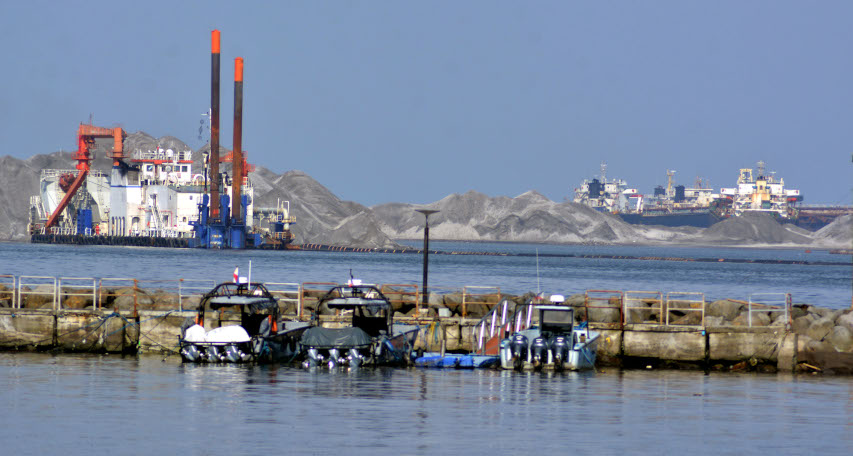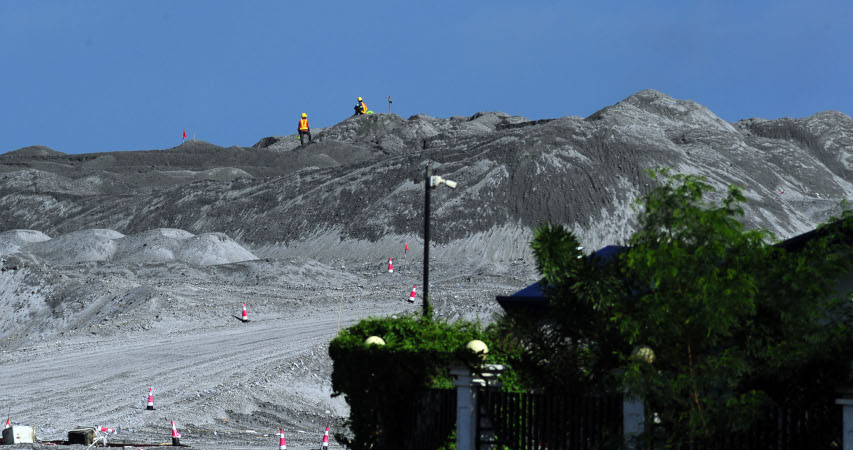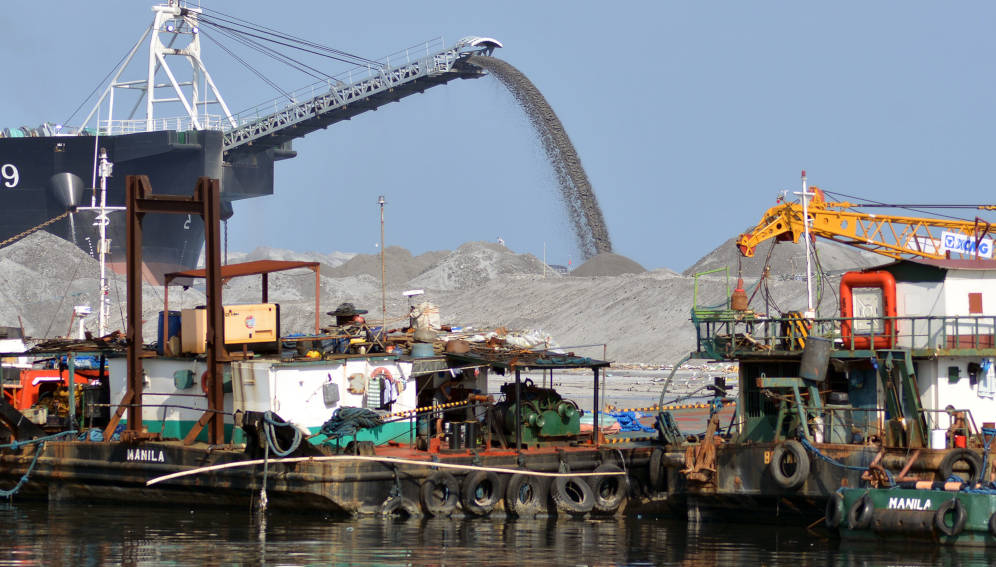By: Gilbert Felongco
Send to a friend
The details you provide on this page will not be used to send unsolicited email, and will not be sold to a 3rd party. See privacy policy.
[MANILA] The Philippine government says it has halted all reclamation projects in Manila Bay amid fears they could worsen chronic flooding in the national capital and surrounding provinces.
Following strong backlash from concerned groups and legislators, Philippine President Ferdinand Marcos Jr. on Monday (7 August) disclosed that all reclamation projects in Manila Bay except one had been suspended pending a review by the Department of Environment and Natural Resources (DENR).
But on Thursday (August 10), DENR Secretary Maria Antonia Yulo-Loyzaga clarified during a briefing that all 22 reclamation projects were under review, without exception.
She said all the reclamations were suspended “until firms reclaiming can comply with the law”.
“Some parts of the Manila Bay are actually subsiding,” she told journalists in Manila.
The proposed reclamations would create over 9,000 hectares of new land for commercial and residential development, about 15 per cent of the size of the entire Metro Manila.
“Willful destruction of our biodiversity is illegal because it violates our constitutional right to a balanced and healthful ecology and displaces the artisanal fishers.”
Liza Osorio, legal and policy director, Oceana Philippines
However, experts and concerned groups warn that the Manila Bay projects could worsen chronic flooding in the capital and surrounding provinces, damage marine life and affect the livelihoods of already struggling fisherfolk.
In several hearings and press briefings, Senator Cynthia Villar criticised the DENR for issuing environmental clearances to 21 reclamation projects without proper consultation with stakeholders.
She said the projects will cause to up to eight metres of floods in southern parts of Metro Manila.
Fernando Siringan, a geologist and professor at the Philippines National Academy of Science and Technology, says the reclamations could lead to more serious flooding in the future as tidal flow in Manila Bay is affected.

Tonnes of sand from dredging equipment seen dumped along Manila Bay. Photo by: Roy Codilla
“Tidal range … within the bay will not necessarily change, it is the tidal range along the rivers and channels that will have measurable change,” Siringan told SciDev.Net.
“Overall, lengthening of rivers and channels [leads] to higher tidal range inland,” he explained, saying that as a result of the land-filling, tidal flooding will inundate a larger area than before.
Currently, parts of Metro Manila closest to the bay like Malabon, Navotas and Valenzuela as well as towns in the adjacent province of Bulacan, contend with regular tidal flooding.
Recent heavy rains in late July and early this month saw parts of Metro Manila and several provinces north of the capital inundated for days displacing over 200,000 people, according to a bulletin issued 4 August by the National Disaster Risk Reduction and Management Council.
Last week, the United States, which has its Philippine embassy in Manila Bay, appeared wary of reclamation works by a Chinese company virtually at its doorstep.
In a statement on 2 August, Kanishka Gangopadhyay, the US Embassy spokesman, expressed concerns about the potential negative long-term and irreversible impacts to the environment caused by the projects.
He also noted that entities involved in the reclamation “have ties to the China Communications Construction Co., which has been added to the U.S. Department of Commerce’s Entity List [trade restriction list] for its role in helping the Chinese military construct and militarize artificial islands in the South China Sea”.
Too many reclamations
Manila Bay has an area of 2,000 square kilometres with a 190-kilometre circumference, stretching from the South China Sea to Southwestern Luzon.
Over the centuries, Manila Bay has grown in importance as a passageway linking the hinterlands of northern and southern Manila to external trade.
Manila Bay’s strategic location has been growing in commercial importance for the region, attracting businesses such as casinos and hotels. With land scarce, reclamation from the sea was the only option.
The reclamation projects in Manila Bay, which are now at various stages of development, straddle several cities in Metro Manila and about eight provinces near the bay.
Similar projects around the country include the 174 hectare-reclamation along Dumaguete City’s coastline, the 230-hectare reclamation in Consolacion, Cebu, and the 100-hectare reclamation in Minglanilla, also in Cebu.
According to the website of not-for-profit Oceana Philippines: “These [reclamation projects] lead to dumping and filling of materials that devastate further and kill our once-rich coastal and marine ecosystems.



Workers on top of the reclaimed area. Photo by: Roy Codilla.
“These not only have negative and irreversible impacts on our coasts, but also to the areas where the filling materials are sourced.”
Liza Osorio, legal and policy director of Oceana Philippines, said: “Similar massive projects in the past have already destroyed thousands of hectares of mangroves, seagrasses and coral reefs and irreversibly destroyed fishing grounds, thereby displacing hundreds of thousands of the fisherfolks and their families.
“Willful destruction of our biodiversity is illegal because it violates our constitutional right to a balanced and healthful ecology and displaces the artisanal fishers. It is also illegal under several environmental laws.”
Yulo-Loyzaga has said the reclamations impede the government’s duty to preserve Manila Bay and uphold its mandate under the Supreme Court’s writ of continuing mandamus.
In 2008, the Philippine Supreme Court directed government agencies to clean up, rehabilitate and preserve Manila Bay and restore and maintain its waters to make them fit for swimming and other recreation.
Conflicting statements on reclamation
It is not clear which project President Marcos was initially referring to as being exempted from the suspension.
During the administration of former president Rodrigo Duterte, which approved most of the ongoing reclamation projects, the government gave conflicting statements touting the rehabilitation and preservation of Manila Bay while approving several reclamation projects.
Environmental lawyer Edna Pana, who had dealt with the Philippine Reclamation Authority in the past, explained to SciDev.Net that securing reclamation permits from the government was difficult.
“It had to be determined first who owns the right to conduct landfilling to a submerged portion of land and has the resources necessary to steward it, this is aside from the activity not being in the Philippine government’s negative list of foreign investments,” she said.
“Before you can be allowed to reclaim, you have to pass through numerous government agencies, such as the Department of Public Works and Highways, if the reclamation also involves construction. Each Department has their own stringent rules to allow applicants to do business.”
But with so many projects going on at the same time there are worries that the cumulative impact would cause irreversible damage.
Yulo-Loyzaga told a previous news briefing that her office would be conducting a review of the “cumulative impact assessment of the different individual projects” in Manila Bay for their impacts on the environment.
She explained that these projects were individually assessed, but the overall impact of all the projects on Manila Bay and surrounding ecosystems was not evaluated. She said that they will also look at the adaptability amid sea-level rise and various geological events such as tsunamis.
This piece was produced by SciDev.Net’s Asia & Pacific desk.
















